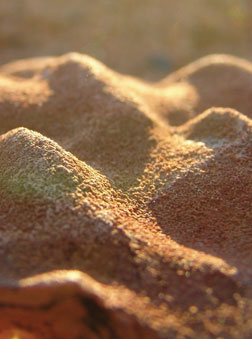|
News Notes
Geomicrobiology
Early life lines make waves
 Life
on Earth just got a little older. New evidence from an ancient rock formation
in Australia is bolstering one side of a long-standing debate: that the
earliest life on Earth helped shape thousands of finely-layered sediment
mounds within the rock.
Life
on Earth just got a little older. New evidence from an ancient rock formation
in Australia is bolstering one side of a long-standing debate: that the
earliest life on Earth helped shape thousands of finely-layered sediment
mounds within the rock.
Microbes likely built these 3.5-billion-year-old “stromatolites” from the Strelley Pool Chert in Australia — making them evidence of the oldest life on Earth, according to new research. Photograph is by Abigail Allwood.
For more than three decades, scientists have pondered the origin of the banded mounds, called stromatolites. Some researchers have posited that the dome- or column-shaped rocks formed as ancient bacteria grew in shallow marine environments, trapping and releasing sediments that subsequently fossilized into distinctive patterns and shapes. Others, however, have said that inorganic physical and chemical processes, such as those around hydrothermal vents, may have shaped the formations.
If the stromatolites are indeed the result of microbial processes, the rocks, some of which are 3.5 billion years old, would be fossils of the oldest life on the planet. The stromatolites’ origin is important not only as an insight into the earliest history and origins of life on Earth, but also as an analogy of how and where life might exist on other planets, says Abigail Allwood, a geologist at Macquarie University in New South Wales, Australia.
To better understand the structures’ origins, Allwood and her colleagues closely examined the Strelley Pool Chert in Western Australia, which contains thousands of stromatolite mounds. In the formation, Allwood and her team identified seven distinct types of stromatolite structures, which range from wavy to crested to egg-carton-shaped.
The complex shapes and the way they were distributed through the ancient environment mimic patterns found in microbial reefs in younger rocks, Allwood says. Other evidence, such as varying thicknesses of layers and changes in grain size not likely to arise from mechanically-driven inorganic processes, suggest that microbes were trapping and binding the sediment, she says.
Furthermore, the environment in which the structures were deposited was not hydrothermal or subject to extreme temperatures, which many researchers suspected was the most likely environment for early life to flourish. Instead, the stromatolites thrived in a more familiar environment to modern life — one with a more moderate range of temperatures and subject to rising seas, the team reported June 8 in Nature.
Allwood’s team’s multiple lines of evidence from the Strelley Pool Chert together provide a compelling argument — perhaps the best to date — that stromatolites are likely to be microbial in origin, says Stanley Awramik, a geologist at the University of California in Santa Barbara. Despite those observations, however, he says that scientists still do not understand exactly how the microbes may have formed them.
One way to gain insight into that formation would be to conduct lab-based experiments of how “microbial mats” grow, to better understand microbe-sediment interactions, Awramik says. Long-term studies and models of modern microbial mats currently growing in marine environments such as Shark Bay in Western Australia and Lee Stocking Island in the Bahamas might also provide some insight, but may not necessarily help to clearly interpret the ancient past, he says.
Understanding how these ancient structures formed may also help in the search for evidence of life elsewhere in the solar system, says Bruce Runnegar, director of the NASA Astrobiology Institute in Moffett Field, Calif. Although such structures would not be expected to exist on an icy moon such as Europa, images of Mars show that layered sediments are common on the red planet, Runnegar says.
“That’s why interpretation of the ones on Earth is so important,” he adds. “If we want to be absolutely certain of what we’re seeing on Mars, we need to understand what we’re seeing on Earth.”
Carolyn Gramling

 Subscribe
Subscribe

